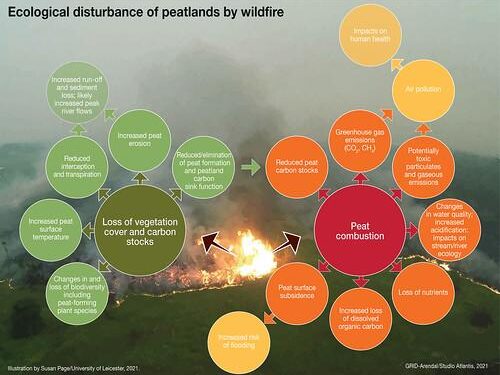Introduction:
As the impacts of climate change intensify, understanding the delicate balance of ecosystems and their services becomes increasingly crucial. Recent research presented in the journal Nature delves into the pressing issue of how various disturbances—ranging from wildfires and invasive species to land-use changes—affect the complex web of benefits that nature provides, such as clean water, carbon sequestration, and biodiversity. This groundbreaking study harnesses advanced quantitative methods to assess the interplay between these disturbances and ecosystem services across different landscapes. By illuminating the intricate relationships within our natural systems, the findings underscore the urgent need for conservation strategies that can adapt to a rapidly changing climate, ensuring that the essential services ecosystems provide are preserved for future generations. As we grapple with an era of unprecedented environmental change, this research offers critical insights into the resilience of our ecosystems and the tangible benefits they deliver to human societies.
Assessing the Impact of Climate Change on Ecosystem Services
The growing evidence of climate change signifies an urgent need to evaluate its repercussions on ecosystem services. These natural processes, which include pollination, water purification, and carbon sequestration, are vital for maintaining biodiversity and supporting human livelihoods. Researchers are now turning their focus to the intricate relationships between changing climate variables and the resulting disturbances that can influence these essential services. By employing advanced modeling techniques, scientists aim to quantify not only the direct impacts of climate shifts but also the cascading effects of disturbances such as wildfires, droughts, and floods.
Key observations from recent studies reveal a concerning trend: as temperatures rise and precipitation patterns shift, the resilience of ecosystems is compromised, which in turn diminishes their capacity to provide crucial services. Among the findings, the following points highlight significant threats to ecosystem functionality:
- Increased Temperature: Alters species interactions, leading to shifts in community structure.
- Prolonged Drought: Reduces plant vitality, impacting carbon storage and water regulation.
- Frequent Flooding: Disturbs habitats, affecting species recovery and nutrient cycling.
To visualize these impacts, a recent study compiled data into a table illustrating the potential decline in ecosystem service provision under varying climate scenarios:
| Climate Scenario | Ecosystem Service Impact (%) |
|---|---|
| Current Baseline | 100 |
| Moderate Climate Change | 75 |
| Severe Climate Change | 50 |
Understanding Disturbance Metrics for Effective Environmental Management
As environmental management continues to face challenges from climate change and escalating disturbances, assessing the impacts of these disturbances on ecosystem services has become crucial. Quantitative disturbance metrics serve as essential tools in this analysis, enabling researchers and policymakers to prioritize actions based on the severity and type of disturbances. Utilizing metrics such as ecological resilience, biodiversity loss, and service delivery changes allows for a comprehensive understanding of how ecosystems respond to external pressures. Tracking these parameters can help in developing adaptive management strategies that better cope with the ongoing transformations in our environment.
To effectively communicate these disturbance impacts, various analytical frameworks and data visualization methods are employed. Among them, an effective approach is the creation of matrices that outline the correlations between different disturbance types and their corresponding effects on ecosystem services. This can be illustrated through a simple table:
| Disturbance Type | Impact on Ecosystem Services |
|---|---|
| Deforestation | Reduced carbon storage, loss of biodiversity |
| Urbanization | Altered water cycles, increased heat islands |
| Climate-driven Events | Soil erosion, habitat destruction |
| Agricultural Expansion | Pollinator decline, nutrient runoff |
This framework not only assists in recognizing critical areas necessitating intervention but also aids in forecasting future scenarios under various climate change trajectories. Stakeholders can utilize this information to implement targeted conservation efforts and policy shifts aimed at mitigating adverse effects on essential ecosystem services, ensuring a sustainable balance between human development and environmental integrity.
Strategic Recommendations for Enhancing Resilience in Ecosystem Services
In light of the challenges posed by climate change, it is imperative to adopt a proactive approach to ecosystem management. Fostering resilience in natural systems can significantly enhance the services they provide, including clean water, carbon sequestration, and biodiversity conservation. Key strategies to bolster this resilience include:
- Strengthening Ecosystem Connectivity: Creating wildlife corridors and protecting fragmented habitats can promote gene flow and enhance adaptive capacity.
- Diverse Crop Selection: In agricultural ecosystems, integrating multiple crop species can buffer against climate variability, ensuring food security and stability in local economies.
- Community Engagement: Involving local stakeholders in conservation efforts fosters a sense of ownership, leading to more sustainable practices and outcomes.
Moreover, investing in research and monitoring systems is essential to understand the intricate dynamics between disturbances and ecosystem services. Establishing a framework for adaptive management can facilitate timely responses to environmental changes. Effective metrics to assess ecosystem health may include:
| Metric | Purpose |
|---|---|
| Biodiversity Index | Tracks species diversity as an indicator of ecosystem stability. |
| Water Quality Assessments | Monitors pollutants and biological indicators to ensure ecosystem services are maintained. |
| Carbon Stock Measurements | Evaluates the effectiveness of carbon sequestration efforts in mitigating climate change. |
In Conclusion
As climate change continues to reshape ecosystems around the globe, understanding the intricate dynamics between disturbances and ecosystem services becomes increasingly critical. The research highlighted in this article underscores the urgent need for comprehensive assessments that quantify these effects, offering valuable insights for policymakers and conservationists alike. By bridging the gap between science and actionable solutions, we can better prepare for a future where ecological resilience is paramount. The ongoing study of disturbances—whether they stem from natural events or human activities—reveals not only the vulnerabilities of our ecosystems but also the potential pathways to restore and sustain the vital services they provide. As we move forward, it is imperative that we keep this knowledge at the forefront of environmental management efforts, ensuring that ecosystems can thrive even in the face of climate uncertainty.































